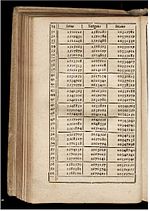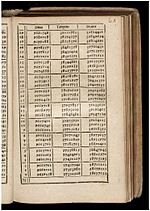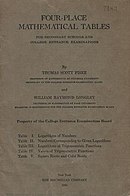326:
25:
358:
342:
135:
34:
381:(base-10) were extensively used in computations prior to the advent of electronic calculators and computers because logarithms convert problems of multiplication and division into much easier addition and subtraction problems. Base-10 logarithms have an additional property that is unique and useful: The common logarithm of numbers greater than one that differ only by a factor of a power of ten all have the same fractional part, known as the
456:("The First Thousand Logarithms"), which gave a brief account of logarithms and a table for the first 1000 integers calculated to the 14th decimal place. Prior to Napier's invention, there had been other techniques of similar scopes, such as the use of tables of progressions, extensively developed by
293:
For tables with greater precision (more digits per value), higher order interpolation may be needed to get full accuracy. In the era before electronic computers, interpolating table data in this manner was the only practical way to get high accuracy values of mathematical functions needed for
257:
function of 75 degrees, 9 minutes, 50 seconds using a table of trigonometric functions such as the
Bernegger table from 1619 illustrated above, one might simply round up to 75 degrees, 10 minutes and then find the 10 minute entry on the 75 degree page, shown above-right, which is 0.9666746.
393:, could easily be determined by counting digits in the original number. A similar principle allows for the quick calculation of logarithms of positive numbers less than 1. Thus a single table of common logarithms can be used for the entire range of positive decimal numbers. See
119:(476–550 CE) is considered the first sine table ever constructed. Āryabhaṭa's table remained the standard sine table of ancient India. There were continuous attempts to improve the accuracy of this table, culminating in the discovery of the
161:
were proposed in the 19th century to tabulate polynomial approximations of logarithmic functions – that is, to compute large logarithmic tables. This was motivated mainly by errors in logarithmic tables made by the
282:
Since there are 60 seconds in a minute of arc, we multiply the difference by 50/60 to get a correction of (50/60)*0.0000745 ≈ 0.0000621; and then add that correction to sin (75° 9′) to get :
185:
in 1938 as a project of the Works
Progress Administration (WPA), employing 450 out-of-work clerks to tabulate higher mathematical functions. It lasted through World War II.
50:. Angles less than 45° are found on the left page, angles greater than 45° on the right. Cosine, cotangent and cosecant are found by using the entry on the opposite page.
223:
is faster than the corresponding calculations (particularly if the computer in question doesn't have a hardware implementation of the calculations). In essence, one
150:
were used until the invention of computers and electronic calculators to do rapid multiplications, divisions, and exponentiations, including the extraction of
541:
290:
A modern calculator gives sin(75° 9′ 50″) = 0.96666219991, so our interpolated answer is accurate to the 7-digit precision of the
Bernegger table.
241:
Trigonometric calculations played an important role in the early study of astronomy. Early tables were constructed by repeatedly applying
881:
166:
of the time. Early digital computers were developed during World War II in part to produce specialized mathematical tables for aiming
428:
615:
Grier, David Alan (1998). "The Math Tables
Project of the Work Projects Administration: The Reluctant Start of the Computing Era".
823:
854:
727:
204:– remains commonplace today, especially in schools, although the use of scientific and graphical calculators as well as
840:
419:, which contains a table of integers and powers of 2 that has been considered an early version of a logarithmic table.
139:
193:
594:
116:
915:
452:
or base-10 logarithms. Napier delegated to Briggs the computation of a revised table. In 1617, they published
219:
technique in computer programming, where the use of such tables speeds up calculations in those cases where a
920:
703:
87:
were common in math and science textbooks, and specialized tables were published for numerous applications.
905:
717:
441:
366:
330:
108:
910:
698:
178:
261:
However, this answer is only accurate to four decimal places. If one wanted greater accuracy, one could
759:
Folkerts, Menso; Launert, Dieter; Thom, Andreas (2016), "Jost Bürgi's method for calculating sines",
436:). The book contained fifty-seven pages of explanatory matter and ninety pages of tables related to
875:
828:
242:
676:
846:
224:
128:
124:
96:
693:
818:
362:
104:
84:
47:
463:
The computational advance available via common logarithms, the converse of powered numbers or
649:
510:
476:
445:
406:
350:
201:
72:
792:
761:
531:
520:
464:
306:
236:
212:
68:
60:
337:
showing the base-10 (common) logarithm of the integers 0 to 67 to fourteen decimal places.
208:
and dedicated statistical software on personal computers is making such tables redundant.
8:
814:
743:
662:
561:
536:
197:
325:
111:(c. 90 – c.168 CE), they were all tables of chords and not of half-chords, that is, the
796:
770:
437:
134:
75:
became cheap and plentiful in the 1970s, in order to simplify and drastically speed up
43:
297:
To understand the importance of accuracy in applications like navigation note that at
245:(like the half-angle and angle-sum identities) to compute new values from old ones.
850:
800:
723:
632:
490:
216:
189:
158:
780:
624:
515:
449:
394:
378:
346:
147:
59:
are lists of numbers showing the results of a calculation with varying arguments.
788:
525:
341:
548:
412:
286:
sin (75° 9′ 50″) ≈ sin (75° 9′) + 0.0000621 = 0.9666001 + 0.0000621 = 0.9666622
163:
120:
899:
870:
784:
636:
370:
314:
182:
457:
310:
220:
874:
566:
553:
500:
423:
386:
262:
205:
76:
715:
357:
33:
24:
571:
100:
628:
495:
298:
167:
80:
64:
775:
505:
592:
302:
192:
are still used. For example, the use of tables of values of the
177:
One of the last major efforts to construct such tables was the
842:
The history of mathematical tables: from Sumer to spreadsheets
484:
171:
138:
These mathematical tables from 1925 were distributed by the
467:, was such that it made calculations by hand much quicker.
254:
112:
889:
385:. Tables of common logarithms typically included only the
294:
applications such as navigation, astronomy and surveying.
63:
were used in ancient Greece and India for applications to
892: : A census of mathematical and astronomical tables.
397:
for details on the use of characteristics and mantissas.
170:. From 1972 onwards, with the launch and growing use of
142:
to students taking the mathematics portions of the tests
42:
Facing pages from a 1619 book of mathematical tables by
131:
with values accurate to seven or eight decimal places.
107:(c.70–140 CE), but both have been lost. Along with the
741:
722:, New York: Holt, Rinehart and Winston, p. 182,
444:
visited Napier in 1615, and proposed a re-scaling of
542:
A Million Random Digits with 100,000 Normal
Deviates
422:
The method of logarithms was publicly propounded by
225:
trades computing speed for the computer memory space
117:
table produced by the Indian mathematician Āryabhaṭa
758:
652:
389:; the integer part of the logarithm, known as the
279:The difference between these values is 0.0000745.
46:, showing values for the sine, tangent and secant
812:
745:John Napier and the invention of logarithms, 1614
716:Vivian Shaw Groza and Susanne M. Shelley (1972),
897:
691:
317:(approximately 1.852 km or 1.151 mi).
434:Description of the Wonderful Rule of Logarithms
838:
157:Mechanical special-purpose computers known as
369:. Columns of differences are included to aid
885:(11th ed.). Cambridge University Press.
593:J J O'Connor and E F Robertson (June 1996).
174:, most mathematical tables went out of use.
127:(c.1350 – c.1425), and the tabulation of a
774:
429:Mirifici Logarithmorum Canonis Descriptio
16:List of values of a mathematical function
869:
692:Bukhshtab, A.A.; Pechaev, V.I. (2001) ,
674:
356:
340:
324:
133:
71:, and continued to be widely used until
824:MacTutor History of Mathematics Archive
752:
320:
230:
898:
614:
588:
586:
361:A page from a table of logarithms of
663:Logarithmic and Trigonometric Tables
301:one minute of arc along the Earth's
123:of the sine and cosine functions by
557:Handbook of Chemistry & Physics
248:
13:
583:
480:Handbook of Mathematical Functions
140:College Entrance Examination Board
90:
14:
932:
863:
748:, Cambridge: The University Press
448:to form what is now known as the
345:Part of a 20th-century table of
528:, a Finnish handbook for science
194:cumulative distribution function
32:
23:
839:Campbell-Kelly, Martin (2003),
806:
103:(c.190 – c.120 BCE) and
742:Ernest William Hobson (1914),
735:
709:
685:
668:
655:
643:
608:
227:required to store the tables.
1:
845:, Oxford scholarship online,
595:"The trigonometric functions"
577:
440:. The English mathematician
665:(Macmillan, New York, 1913).
426:in 1614, in a book entitled
367:American Practical Navigator
7:
876:"Table, Mathematical"
699:Encyclopedia of Mathematics
675:Stifelio, Michaele (1544),
470:
454:Logarithmorum Chilias Prima
335:Logarithmorum Chilias Prima
179:Mathematical Tables Project
10:
937:
819:"Jost Bürgi (1552 – 1632)"
487:, a Dutch science handbook
404:
400:
268:From the Bernegger table:
234:
211:Creating tables stored in
109:surviving table of Ptolemy
272:sin (75° 10′) = 0.9666746
99:known to be made were by
829:University of St Andrews
785:10.1016/j.hm.2016.03.001
681:, London: Iohan Petreium
275:sin (75° 9′) = 0.9666001
243:trigonometric identities
181:that was started in the
882:Encyclopædia Britannica
847:Oxford University Press
719:Precalculus mathematics
363:trigonometric functions
125:Madhava of Sangamagrama
121:power series expansions
97:trigonometric functions
85:trigonometric functions
48:trigonometric functions
916:History of mathematics
617:IEEE Ann. Hist. Comput
374:
354:
349:in the reference book
338:
202:standard normal tables
172:scientific calculators
143:
73:electronic calculators
650:Abramowitz and Stegun
511:History of logarithms
477:Abramowitz and Stegun
407:History of logarithms
360:
351:Abramowitz and Stegun
344:
328:
265:linearly as follows:
137:
129:sine table by Madhava
921:Tables (information)
815:Robertson, Edmund F.
762:Historia Mathematica
532:Multiplication table
465:exponential notation
321:Tables of logarithms
237:Trigonometric tables
231:Trigonometric tables
213:random-access memory
95:The first tables of
69:celestial navigation
61:Trigonometric tables
906:Mathematical tables
813:O'Connor, John J.;
678:Arithmetica Integra
562:Table (information)
537:Random number table
446:Napier's logarithms
417:Arithmetica integra
198:normal distribution
57:Mathematical tables
911:Mathematical tools
438:natural logarithms
377:Tables containing
375:
355:
339:
159:difference engines
144:
44:Matthias Bernegger
856:978-0-19-850841-0
729:978-0-03-077670-0
629:10.1109/85.707573
491:Difference engine
379:common logarithms
347:common logarithms
217:code optimization
190:special functions
148:common logarithms
928:
886:
878:
859:
832:
831:
810:
804:
803:
778:
756:
750:
749:
739:
733:
732:
713:
707:
706:
689:
683:
682:
672:
666:
659:
653:
647:
641:
640:
612:
606:
605:
603:
601:
590:
516:Nautical almanac
395:common logarithm
249:A simple example
36:
27:
936:
935:
931:
930:
929:
927:
926:
925:
896:
895:
866:
857:
835:
811:
807:
757:
753:
740:
736:
730:
714:
710:
690:
686:
673:
669:
661:E. R. Hedrick,
660:
656:
648:
644:
613:
609:
599:
597:
591:
584:
580:
473:
409:
403:
323:
253:To compute the
251:
239:
233:
164:human computers
93:
91:History and use
54:
53:
52:
51:
39:
38:
37:
29:
28:
17:
12:
11:
5:
934:
924:
923:
918:
913:
908:
894:
893:
887:
873:, ed. (1911).
871:Chisholm, Hugh
865:
864:External links
862:
861:
860:
855:
834:
833:
805:
769:(2): 133–147,
751:
734:
728:
708:
684:
667:
654:
642:
607:
581:
579:
576:
575:
574:
569:
564:
559:
551:
549:Reference book
546:
545:
544:
534:
529:
523:
518:
513:
508:
503:
498:
493:
488:
482:
472:
469:
413:Michael Stifel
405:Main article:
402:
399:
391:characteristic
365:from the 2002
322:
319:
288:
287:
277:
276:
273:
250:
247:
235:Main article:
232:
229:
115:function. The
92:
89:
41:
40:
31:
30:
22:
21:
20:
19:
18:
15:
9:
6:
4:
3:
2:
933:
922:
919:
917:
914:
912:
909:
907:
904:
903:
901:
891:
888:
884:
883:
877:
872:
868:
867:
858:
852:
848:
844:
843:
837:
836:
830:
826:
825:
820:
816:
809:
802:
798:
794:
790:
786:
782:
777:
772:
768:
764:
763:
755:
747:
746:
738:
731:
725:
721:
720:
712:
705:
701:
700:
695:
688:
680:
679:
671:
664:
658:
651:
646:
638:
634:
630:
626:
622:
618:
611:
596:
589:
587:
582:
573:
570:
568:
565:
563:
560:
558:
555:
552:
550:
547:
543:
540:
539:
538:
535:
533:
530:
527:
524:
522:
519:
517:
514:
512:
509:
507:
504:
502:
499:
497:
494:
492:
489:
486:
483:
481:
478:
475:
474:
468:
466:
461:
460:around 1600.
459:
455:
451:
447:
443:
439:
435:
431:
430:
425:
420:
418:
414:
408:
398:
396:
392:
388:
384:
380:
372:
371:interpolation
368:
364:
359:
352:
348:
343:
336:
332:
327:
318:
316:
315:nautical mile
313:) equals one
312:
309:(indeed, any
308:
304:
300:
295:
291:
285:
284:
283:
280:
274:
271:
270:
269:
266:
264:
259:
256:
246:
244:
238:
228:
226:
222:
218:
214:
209:
207:
203:
199:
195:
191:
186:
184:
183:United States
180:
175:
173:
169:
165:
160:
155:
153:
149:
141:
136:
132:
130:
126:
122:
118:
114:
110:
106:
102:
98:
88:
86:
82:
78:
74:
70:
66:
62:
58:
49:
45:
35:
26:
880:
841:
822:
808:
766:
760:
754:
744:
737:
718:
711:
697:
694:"Arithmetic"
687:
677:
670:
657:
645:
623:(3): 33–50.
620:
616:
610:
598:. Retrieved
556:
479:
462:
453:
442:Henry Briggs
433:
427:
421:
416:
410:
390:
382:
376:
334:
331:Henry Briggs
329:A page from
311:great circle
296:
292:
289:
281:
278:
267:
260:
252:
240:
221:table lookup
215:is a common
210:
200:– so-called
187:
176:
156:
151:
145:
94:
79:. Tables of
56:
55:
567:Truth table
554:Rubber book
501:Group table
424:John Napier
263:interpolate
206:spreadsheet
77:computation
900:Categories
776:1510.03180
578:References
572:Jurij Vega
458:Jost Bürgi
415:published
188:Tables of
154:th roots.
146:Tables of
101:Hipparchus
81:logarithms
801:119326088
704:EMS Press
637:1058-6180
496:Ephemeris
411:In 1544,
387:mantissas
299:sea level
168:artillery
65:astronomy
506:Handbook
471:See also
383:mantissa
307:meridian
105:Menelaus
890:LOCOMAT
793:3489006
600:4 March
401:History
333:' 1617
303:equator
196:of the
853:
799:
791:
726:
635:
521:Matrix
450:common
797:S2CID
771:arXiv
485:BINAS
305:or a
851:ISBN
724:ISBN
633:ISSN
602:2010
526:MAOL
255:sine
113:sine
83:and
67:and
781:doi
625:doi
902::
879:.
849:,
827:,
821:,
817:,
795:,
789:MR
787:,
779:,
767:43
765:,
702:,
696:,
631:.
621:20
619:.
585:^
783::
773::
639:.
627::
604:.
432:(
373:.
353:.
152:n
Text is available under the Creative Commons Attribution-ShareAlike License. Additional terms may apply.


